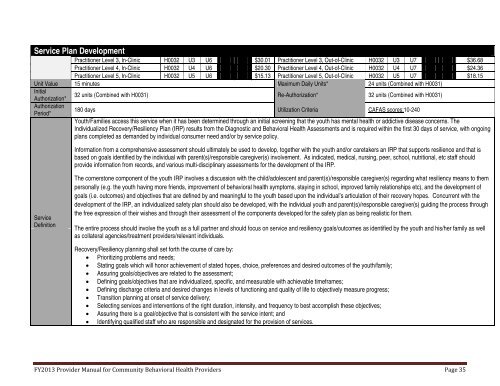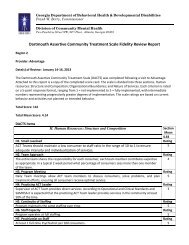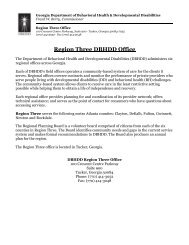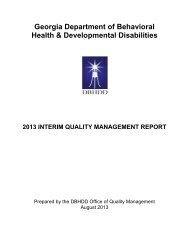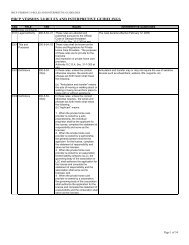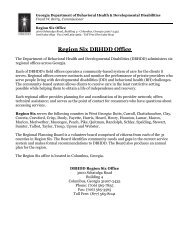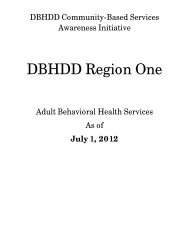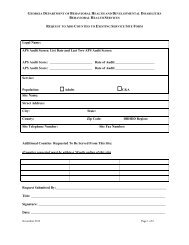PART I - Department of Behavioral Health and Developmental ...
PART I - Department of Behavioral Health and Developmental ...
PART I - Department of Behavioral Health and Developmental ...
You also want an ePaper? Increase the reach of your titles
YUMPU automatically turns print PDFs into web optimized ePapers that Google loves.
Service Plan DevelopmentPractitioner Level 3, In-Clinic H0032 U3 U6 $30.01 Practitioner Level 3, Out-<strong>of</strong>-Clinic H0032 U3 U7 $36.68Practitioner Level 4, In-Clinic H0032 U4 U6 $20.30 Practitioner Level 4, Out-<strong>of</strong>-Clinic H0032 U4 U7 $24.36Practitioner Level 5, In-Clinic H0032 U5 U6 $15.13 Practitioner Level 5, Out-<strong>of</strong>-Clinic H0032 U5 U7 $18.15Unit Value 15 minutes Maximum Daily Units* 24 units (Combined with H0031)InitialAuthorization*AuthorizationPeriod*32 units (Combined with H0031) Re-Authorization* 32 units (Combined with H0031)180 days Utilization Criteria CAFAS scores:10-240Youth/Families access this service when it has been determined through an initial screening that the youth has mental health or addictive disease concerns. TheIndividualized Recovery/Resiliency Plan (IRP) results from the Diagnostic <strong>and</strong> <strong>Behavioral</strong> <strong>Health</strong> Assessments <strong>and</strong> is required within the first 30 days <strong>of</strong> service, with ongoingplans completed as dem<strong>and</strong>ed by individual consumer need <strong>and</strong>/or by service policy.Information from a comprehensive assessment should ultimately be used to develop, together with the youth <strong>and</strong>/or caretakers an IRP that supports resilience <strong>and</strong> that isbased on goals identified by the individual with parent(s)/responsible caregiver(s) involvement. As indicated, medical, nursing, peer, school, nutritional, etc staff shouldprovide information from records, <strong>and</strong> various multi-disciplinary assessments for the development <strong>of</strong> the IRP.ServiceDefinitionThe cornerstone component <strong>of</strong> the youth IRP involves a discussion with the child/adolescent <strong>and</strong> parent(s)/responsible caregiver(s) regarding what resiliency means to thempersonally (e.g. the youth having more friends, improvement <strong>of</strong> behavioral health symptoms, staying in school, improved family relationships etc), <strong>and</strong> the development <strong>of</strong>goals (i.e. outcomes) <strong>and</strong> objectives that are defined by <strong>and</strong> meaningful to the youth based upon the individual’s articulation <strong>of</strong> their recovery hopes. Concurrent with thedevelopment <strong>of</strong> the IRP, an individualized safety plan should also be developed, with the individual youth <strong>and</strong> parent(s)/responsible caregiver(s) guiding the process throughthe free expression <strong>of</strong> their wishes <strong>and</strong> through their assessment <strong>of</strong> the components developed for the safety plan as being realistic for them.The entire process should involve the youth as a full partner <strong>and</strong> should focus on service <strong>and</strong> resiliency goals/outcomes as identified by the youth <strong>and</strong> his/her family as wellas collateral agencies/treatment providers/relevant individuals.Recovery/Resiliency planning shall set forth the course <strong>of</strong> care by:• Prioritizing problems <strong>and</strong> needs;• Stating goals which will honor achievement <strong>of</strong> stated hopes, choice, preferences <strong>and</strong> desired outcomes <strong>of</strong> the youth/family;• Assuring goals/objectives are related to the assessment;• Defining goals/objectives that are individualized, specific, <strong>and</strong> measurable with achievable timeframes;• Defining discharge criteria <strong>and</strong> desired changes in levels <strong>of</strong> functioning <strong>and</strong> quality <strong>of</strong> life to objectively measure progress;• Transition planning at onset <strong>of</strong> service delivery;• Selecting services <strong>and</strong> interventions <strong>of</strong> the right duration, intensity, <strong>and</strong> frequency to best accomplish these objectives;• Assuring there is a goal/objective that is consistent with the service intent; <strong>and</strong>• Identifying qualified staff who are responsible <strong>and</strong> designated for the provision <strong>of</strong> services.FY2013 Provider Manual for Community <strong>Behavioral</strong> <strong>Health</strong> Providers Page 35


